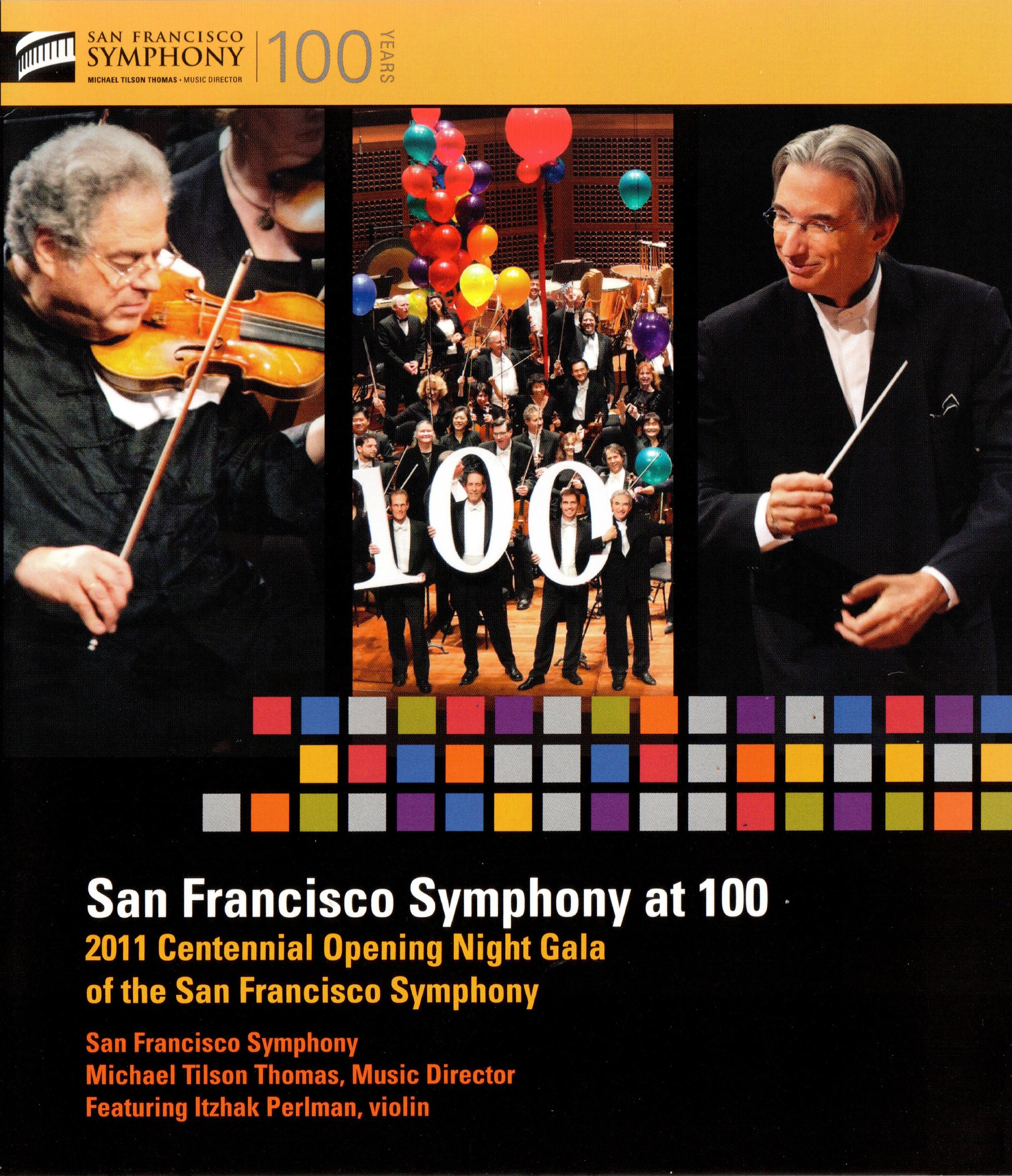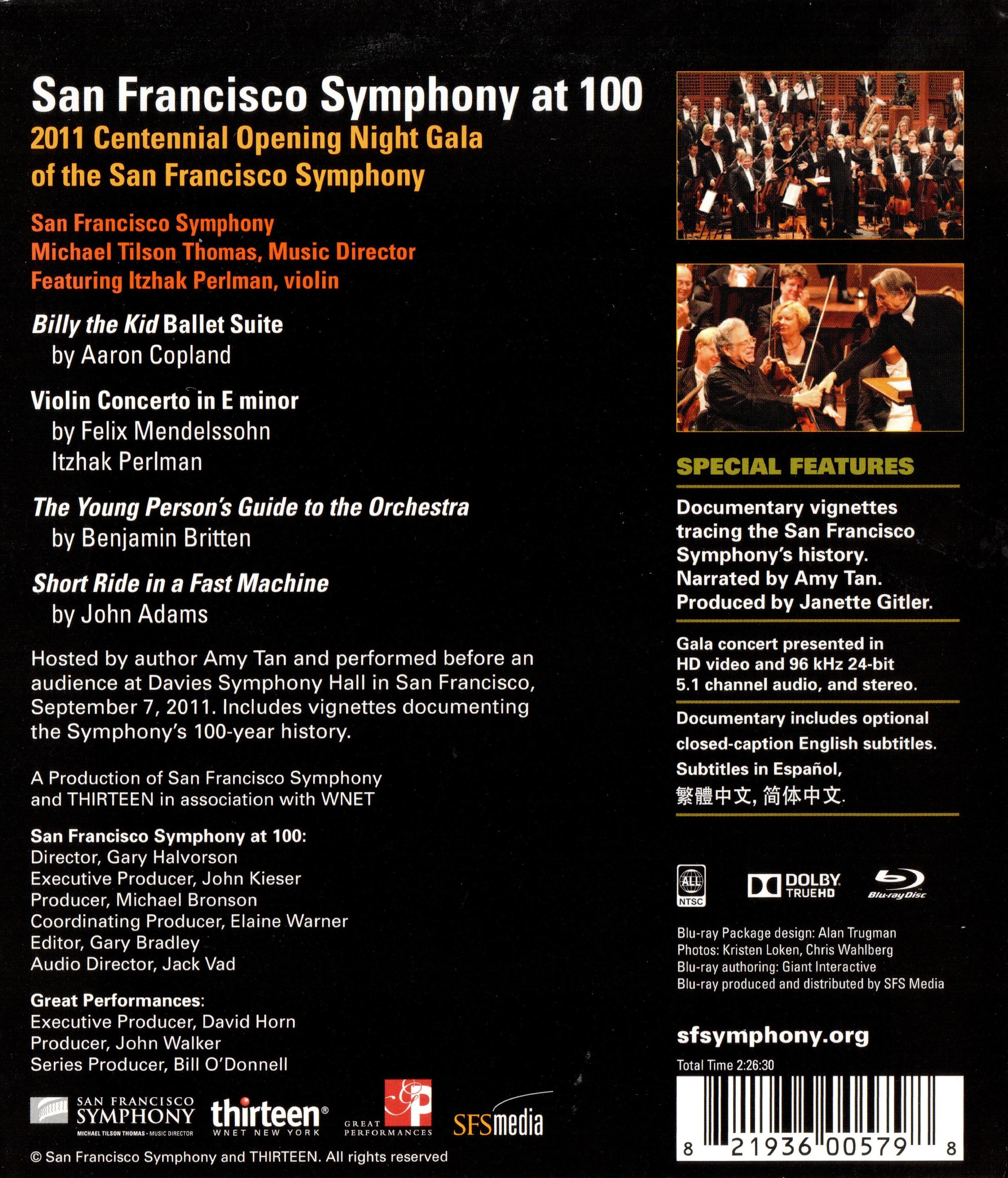

San Francisco Symphony at 100 concert. Michael Tilson Thomas conducts the San Francisco Symphony in a gala concert in honor of the San Francisco Symphony's first centenary. Here’s the program:
Aaron Copland - Billy the Kid Ballet Suite
Felix Mendelssohn - Violin Concerto in E minor (Itzhak Perlman)
Benjamin Britten - The Young Person's Guide to the Orchestra
John Adams - Short Ride in a Fast Machine
Also included is a 58-minute documentary narrated by Amy Tan about the history of the San Francisco Symphony. Directed for TV by Gary Halvorson; audio direction by Jack Vad. This disc is self-published by the San Francisco Symphony on the SFSmedia label. It has an "all-regions” logo on the back of the keep case.
The Blu-ray disc is, per information on the keep case, "presented" in 96kHz/24 bit sound. We at first thought this meant that 96kHz/24 bit sampling technology was used to originally record the concert material. But this is not correct; the original recording was made at 48kHz. Then it was "upgraded" with something called "Advanced Dolby TrueHD" so that there is a 96kHz/24 file on the disc. The idea that you can improve the sound of a recording this way is, of course, pure puffing at best and false advertising at worst. And if 96kHz/24 is a good idea, why not use this for the original sound sampling? Snake-oil claims like Advanced Dolby TrueHD are common in the marketplace, but it's discouraging to see this coming from a public charity. Grade: C
This title is primarily a resource or souvenir for folks who are interested in the history of the San Francisco Symphony. The San Francisco Symphony has had a lot of famous conductors. The documentary of 58 minutes (in stereo and mostly old black and white legacy video) is more interesting than we thought it would be, but we doubt that many people would watch this more than once or twice. Portions of the documentary are mixed in with the concert, probably to make it more interesting as a TV program.
So what about the 75-minute gala concert? We note that the pieces presented are pretty light—more suitable for a "pops" or gala event than a normal symphony concert. But nobody will be harmed by watching this.
But we have another criticism for this title: all the concert video in this title was shot with DVD in mind. This is not acceptable in an HDVD recording of a symphony orchestra. We have drawn the battle lines on this subject in our special article on standards for HDVD video content. If you have not recently read this article, please do so now as the menu has changed. We will not repeat here all the principles set out in our article. But we will explain how our standards apply to the works presented in this SFS gala concert.
Billy the Kid Ballet Suite
This is maybe the most exasperating example we have seen of a DVD masquerading as an HDVD. A DVD by its nature has to be a string of fast close-up shots of the conductor and small parts of the orchestra. The good HDVD shoot is the opposite: it should be a calm presentation with a mix of long-range and shorter-range shots (plus close-ups) centered on the orchestra rather than the conductor. No one video can serve both the DVD and HDVD masters.
This Billy the Kid lasts 20 minutes, 15 seconds, and we count no fewer than 428 cuts. That works out to 2.8 seconds per clip, maybe the fastest video pace ever. We think the ideal HDVD of a symphony should have an average clip time of of 12 to 15+ seconds; this suggests that this Billy the Kid is moving as much as 4 or 5 times faster than it should on Blu-ray. Another hallmark of a DVD symphony recording is the use of "easy shots" like the conductor alone, the conductor seen over the backs of the orchestra members, and "instrument-only" views. Well, we count 106 shots of the conductor alone, 28 shots of the conductor shot over the backs of the players, and 67 shots of instruments in which you don't see the player. This means that in 47% of this video, you don't clearly see the face of any player in the orchestra.
The vast majority of the players you do see are solos, sections of 2 players, or meaningless shots of tiny parts of the larger sections. In the good HDVD, we want to see many shots of the whole orchestra and the large sections. This is almost completely missing in this Billy the Kid with only 6 whole-orchestra shots. They are worth little for the following reasons: the shot at 5:16 proves how beautiful it could be, but lasts only 2 seconds; the shot at 7:28 is too far back so that the orchestra only takes up about 60% of the frame; the lovely shot at 11:21 is snuffed out after 2 seconds of life; the stupid shot at 14:00 takes up only 20% of the frame (there are two of these); the shot at 14:35 takes up only 80% of the frame; and the shot at 21:26 (best of the miserable bunch) lasts only 4 seconds.
In addition, the TV director has many other problems. The PQ is a tad soft. His cameraman can't get 4 horns in a row in good focus. There is confusing and senseless panning around in large string sections. The director allows at least 3 shots (see 6:08) where the screen is divided diagonally to show 2 different instrument-only shots on the screen at one time, and there is another similar shot where you see two players simultaneously on the same screen (18:29). These split-screen shots would not make the grade in a college video project.
One could argue that the musical structure of Billy the Kid lends itself to short video clips. Probably this is correct for a DVD where close-ups is the main tool the TV director has. In DVD, the TV director has to take the "look-mom-what-I-can-do" approach even if it threatens the viewer with a migraine. But with the power of high-def cameras, the TV director can do so much more. And the best thing he can do is structure a balanced program that gives the viewer a lot of big pictures to enjoy.
For bad video content and unexciting picture quality, we give Billy a D.
Mendelssohn Violin Concerto
In a concerto the focus is on the soloist. Even in a DVD this tends to result in a slowdown in the pace of cuts. The TV director can have long close-ups of the soloist and the result will be pleasant to the viewer. Here we count 177 cuts in 28 minutes, which works out to a fairly pleasant average of 9.5 seconds per cut. Perlman gets 58% of the cuts. Because his cuts tend to be long, he maybe gets 70% of the air time.
So who gets the bulk of the attention in the remaining 42% of the cuts or 30% of air time? In this video, the attention goes overwhelmingly to the conductor. First there are 7 shots of the conductor only. Then there are 17 shots of the conductor made over the backs of the musicians. The worst of these is 22 seconds from 30:17 to 30:39 when the orchestra comes in for the first time in tutti after the soloist gets things going. This is precisely when we should get 22 full seconds of the whole band—but all we see is the conductor and a sea of the backs of players. In addition to this there are a number of shots of parts of the orchestra which don't made any particular sense, but do give the TV director another way to put the conductor close to the middle of the frame.
We should also mention that quite a few of the shots of Perlman are framed so that the conductor is also there. We get to admire a close-up of the back of the conductor's head and left of his fanny, which is not our idea of a high-value photo. Finally, there are 6 whole-orchestra shots. But only one of these is good; the rest are too short or ruined by the perverse DVD habit of framing a decent shot and then immediately zooming in to turn it into a close-up.
So now what grade should we give this? The Perlman performance would get an A, but the shabby treatment of the orchestra would warrant a D. Blending these grades suggests a final B. But we move that up to B+ on account of the excellent balance of sound we hear between Perlman and the orchestra.
The Young Person's Guide to the Orchestra
The video content of Guide is similar to that in the Billy the Kid. 41% of the cuts are easy shots of the conductor or instruments without players. The average shot lasts 3.2 seconds. There is only a single good whole orchestra shot (see 1:18:04, which lasts 6 seconds). So the Guide gets a D.
Apparently there's always a temptation to shoot a DVD and then try to pimp it out as an HDVD in sexy Blu-ray dress. We can understand why commercial publishers do this, faced as they always are with pressure to boost the bottom line. But it's discouraging to see what poor HDVD video content we are getting here from the great SFS, a public charity which claims a tradition of using the latest technology and seeks, they declare, always to be among the best. The SFS has total control over its venue and sophisticated recording gear. Why can't they work out a shooting plan that would allow them to produce two videos: one for DVD and the other for HDVD?
The folks at SFS ought to ask themselves these questions:
What are the best video content practices for HDVD recordings of symphony music?
If you are going to claim any use of 96kHz/24 bit sound technology, why not go whole hog and use the best stuff from A to Z?
Does a public charity have a special ethical obligation to avoid commercial "puffing" of products it sells and to be scrupulously accurate about the claims it makes for those products?
Was SFS being tricky in stating on the package that the SFS 100 recording is "presented" in 96kHz/24 bit audio?
Did the video content in this 100 Year Gala Blu-ray disc honor the players in the SFS, or does it in fact insult them?
Would any viewer want to see this concert in HDVD more than once?
Does SFSmedia in releasing this type of disc threaten the reputation of Michael Tilson Thomas by making him appear to be some kind of out-of-control egomaniac?
If the SFS can't afford to produce both DVDs and Blu-rays as separate shows, is it time now to drop DVD and make only HDVDs following best practices for that product?
Now for a grade for the disc. The Perlman concerto got B+. The other two works got D. This suggests C- as the overall grade. But the documentary is nice, so we move the final grade to C. Overall, this title is a big disappointment other than as a souvenir.
Purchase at:
